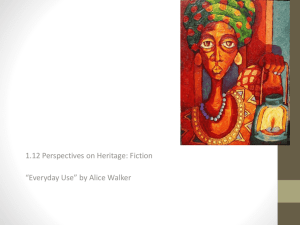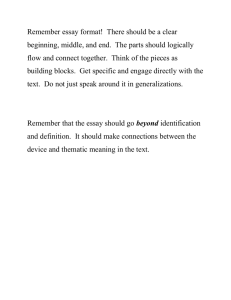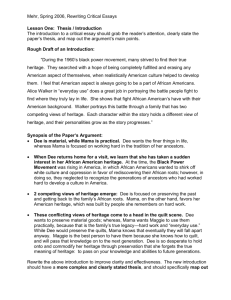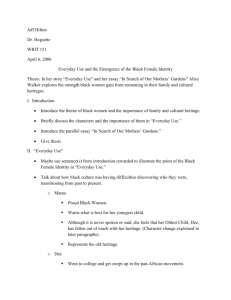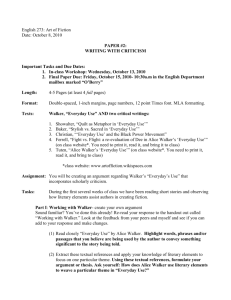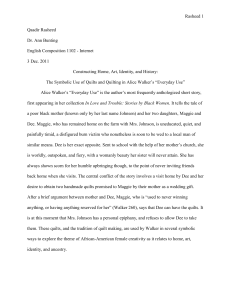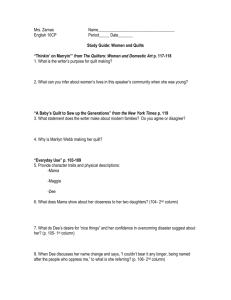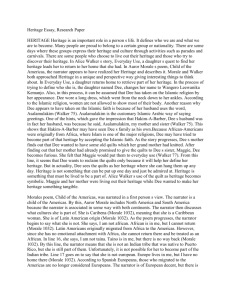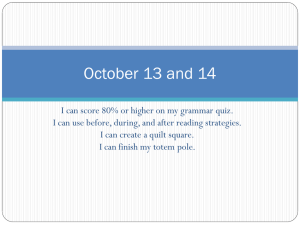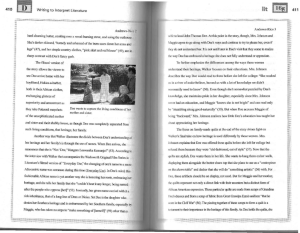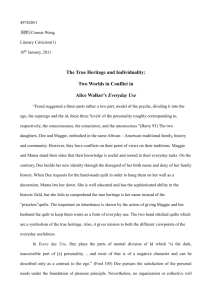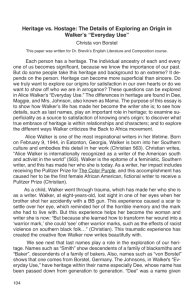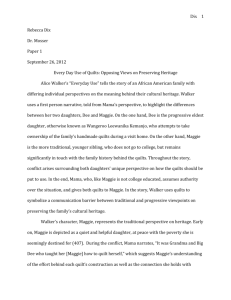Ms. Platte`s presentation
advertisement
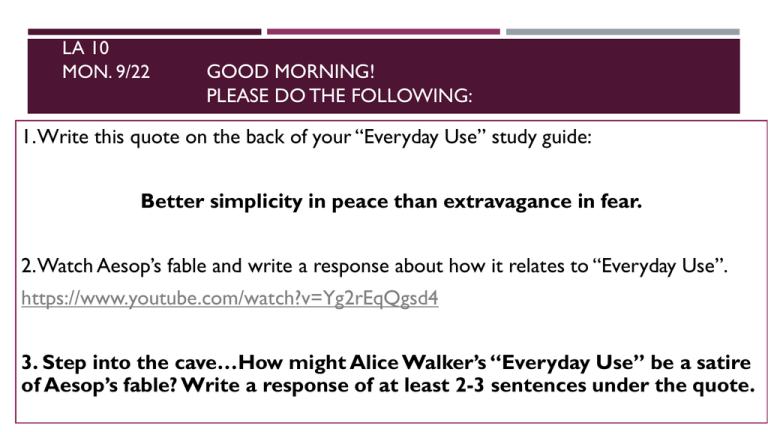
LA 10 MON. 9/22 GOOD MORNING! PLEASE DO THE FOLLOWING: 1. Write this quote on the back of your “Everyday Use” study guide: Better simplicity in peace than extravagance in fear. 2. Watch Aesop’s fable and write a response about how it relates to “Everyday Use”. https://www.youtube.com/watch?v=Yg2rEqQgsd4 3. Step into the cave…How might Alice Walker’s “Everyday Use” be a satire of Aesop’s fable? Write a response of at least 2-3 sentences under the quote. LITERARY ANALYSIS Walker is, “[satirizing] the heady rhetoric of late ‘60s black consciousness, deconstructing its religiousness (especially the rediscovery of Africa) and asserting neglected values” (Cowart, 1996). But Walker’s main purpose in the story seems to be to challenge the Black Power movement and black people in general, to acknowledge and respect their American heritage. The history of Africans in America is filled with stories of pain, injustice, and humiliation. It is not as pleasing as a colorful African heritage that can be fabricated, like a quilt, from bits and pieces that one finds attractive. It is a real heritage that is comprised of real people: people who are deserving of respect and admiration (White, 2001). MAMA CD: Her description of herself likewise shows a familiarity and comfort with her surroundings and with herself: she is “a large, big-boned woman with rough, man-working hands” (315)—in other words, she knows the reality of her body and accepts it, even finding comfort (both physical and psychological) in the way that her “fat keeps [her] hot in zero weather” (315). CM: Mrs. Johnson is fundamentally at home with herself; she accepts who she is, and thus, Walker implies, where she stands in relation to her culture. MAGGIE CD: Maggie is described as rather unattractive and shy: the scars she bears on her body have likewise scarred her soul, and, as a result, she is retiring, even frightened. Mrs. Johnson admits, in a loving manner, that “like good looks and money, quickness passed her by” (73). CM: She “stumbles” as she reads, but clearly Mrs. Johnson thinks of her as a sweet person, a daughter with whom she can sing songs at church. Most importantly, however, Maggie is, like her mother, at home in her traditions, and she honors the memory of her ancestors; for example, she is the daughter in the family who has learned how to quilt from her grandmother. DEE CD: Dee, however, is virtually Maggie’s opposite. She is characterized by good looks, ambition, and education (Mrs. Johnson, we are told, collects money at her church so that Dee can attend school). Dee’s education has been extremely important in forging her character, but at the same time it has split her off from her family. Mamma says, “She used to read to us without pity; forcing words, lies, other folks’ habits, whole lives upon us two, sitting trapped and ignorant underneath her voice” (73). CM: Dee, in other words, has moved towards other traditions that go against the traditions and heritage of her own family: she is on a quest to link herself to her African roots and has changed her name to Wangero Leewanika Kemanjo. In doing so, in attempting to recover her “ancient” roots, she has at the same time denied, or at least refused to accept, her more immediate heritage, the heritage that her mother and sister share. What is most crucial about these quilts—and what Dee does not understand—is that they are made up of daily life, from materials that were lived in. SAMPLE THEME STATEMENTS Walker employs characterization and symbolism to show that culture and heritage are parts of daily life. Alice Walker illustrates in “Everyday Use” that true heritage must be part of people’s use every day, and not hung on a wall like a museum display.



![Short_Story_Test[1].doc](http://s3.studylib.net/store/data/008002238_1-7a5ad2a7af6a9cd4f4b95cb6fd0a8215-300x300.png)

